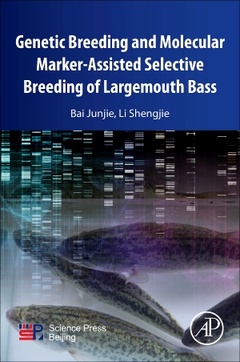Genetic Breeding and Molecular Marker-Assisted Selective Breeding of Largemouth Bass
Auteurs : Junjie Bai, Shengjie Li

Genetic Breeding and Molecular Marker-Assisted Selective Breeding of Largemouth Bass provides evidenced-based research that summarizes the theory and practice of genetic breeding. It provides a theoretical basis and technical support for the genetic improvement of largemouth bass varieties, but is also a good reference on the genetic breeding of other farmed fish. As knowledge of systematic studies, including germplasm resources, biology, quantitative genetics, selection breeding, variety hybridization and molecular marker assisted breeding is needed to increase growth performance, this book provides comprehensive information that is suitable for aquatic genetic breeding researchers and undergraduate and graduate students in aquatic genetics and breeding.
1. Germplasm resources of largemouth bass2. The genetic parameters of growth traits and breeding value estimation in largemouth bass (Micropterus salmoides) 3. Breeding new varieties of largemouth bass4. Hybridization between subspecies of largemouth bass5. Molecular marker-assisted selective breeding of largemouth bass
Researchers and students in the fields of aquaculture genetics, genomics and breeding as well as fish farmers
Research fish biologists
Born in Fuzhou, Fujian province of China in January 1957. Graduated from the department of biology of Xiamen University in 1982, with a master's degree in aquaculture at Shanghai Fisheries University in 2000. Now work as a professor at the Pearl River Fisheries Research Institute of CAFS, the chief scientist of aquatic biotechnology in the Chinese Academy of Fisheries Sciences, the director of Key Laboratory of Tropical & Subtropical Fishery Resource Application & Cultivation, Ministry of Agriculture of China, and was the deputy director of the Pearl River Fisheries Research Institute of CAFS. The main research focuses on the fish genetic breeding and aquatic biotechnology. Has hosted a national science and technology support projects, the national 863 high-tech project, the foundation of the national science and technology projects, the ministry of agriculture "948" project, the natural science foundation of Guangdong province and Guangdong province science and technology plan projects and so on more than 20 scientific research projects. The new varieties “Youlu No.1 largemouth bass which grows by 20% was approved by National Certification Committee for Aquatic Varieties, and as a major breeding variety widely used in China. In 2015, the annual production of Youlu No. 1 largemouth bass reached 180,000 tons.
Over the past 30 years, more than 10 technical awards were received from government of Guangdong Province, the Ministry of Agriculture of China and Chinese Academy of Fishery Sciences. More than 250 research papers have been published by leading authors in journals.
Li Shengjie, Associate professor and associate director of biotech research laboratory
- Presents research on the collection, conservation and evaluation of domestic and abroad germplasm resources, basic biology and genetics, and different types of breeding
- Provides both theory and practical application to enhance the growth and development of new species of fish
- Includes methods to analyze data results and better predict research outcomes
Date de parution : 03-2019
Ouvrage de 332 p.
15x22.8 cm
Thèmes de Genetic Breeding and Molecular Marker-Assisted Selective... :
Mots-clés :
Breeding value; Correlation; D-loop; DNA fingerprinting; Dominant genotype; Florida subspecies; Functional genes; Genetic diversity; Growth rate; Growth traits; Heritability; High yield; Hybridization; Identification; Largemouth bass; Microsatellite; Molecular-assisted selective breeding; Morphological characteristics; Morphological trait; MtDNA; Northern subspecies; Nutritional component; Oxygen consumption rate; Population selection; Pyramiding; Rearing model; SNP; Suffocation point; Youlu No1 largemouth bass



